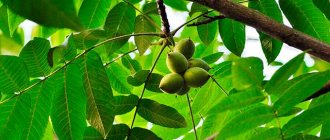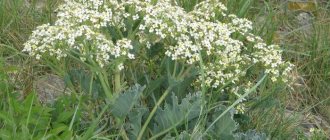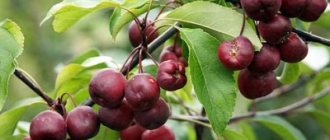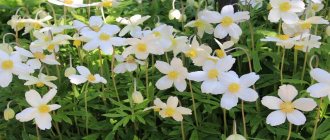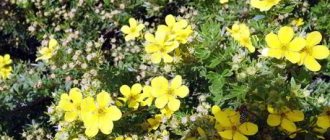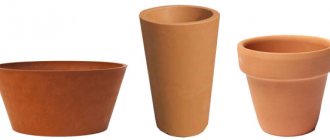About the benefits of lemon balm herb, growing from seeds. How to care for and when to harvest. Description of species and varieties, photos.
I continue the series “My Apothecary Garden” with a story about lemon balm. It turns out that there are several species within the genus. The most common is lemon balm. There are varieties in stores that differ in the size of the bush, the type of leaves, and the intensity of the aroma.
The word Melissa has a Greek equivalent - Μέλισσα. Translated as “honey bee”. This is a favorite plant of bees, for which it is also popularly called: honeywort, swarmer, beeworm. Any lemon balm has a lemon aroma, hence another name - lemon balm.
Melissa
Melissa varieties for growing on a windowsill
The medicinal perennial has been cultivated by gardeners for a long time. Unlike growing in open ground, homemade lemon balm is not as fragrant. However, breeders have developed the best varieties for home use.
| Variety | Characteristic |
| "Lemon aroma" | Grows in small bushes. The variety grows well both at home and in the country. |
| "Mahito" | Mainly used in cooking. The main direction is desserts and cocktails. |
| "Pure gold" | During flowering, the plant changes color from white to blue. One of the most unpretentious varieties. The bushes grow fluffy. The variety is rare. |
| "variegated" | Decorative type of grass. A characteristic feature is the golden color along the edges of the leaves. |
| "Lemon tea" | Has a pronounced lemon scent. An unpretentious plant to care for. |
| "Pearl" | Bushes 65-70 centimeters high. The leaves are dark green with jagged edges. After 60 days you can harvest. |
| "Freshness" | Ripening time is 2 months from the start of planting. The leaves have a fresh lemon aroma and a bitter taste. |
All types of lemon balm have similar beneficial properties. Differences can only be in the shape of the bush, in the volume of green mass and in the timing of ripening.
Have you ever grown lemon balm at home?
Of course not yet
Classic lemon balm
Here the seed producers did not apply any imagination and did not give the variety a name. It is understood that this is a classic lemon balm with a shoot height of up to 1 m. The leaves are light green and have a light , pleasant aroma. They can be dried or added fresh to tea, salads, pickles, and used as medicine.
Melissa classic
About the benefits: lemon balm leaves contain ascorbic acid, a lot of carotene and essential oils. They have calming, analgesic, wound-healing and antispasmodic properties.
Melissa tea: 1-2 tsp. pour a cup of boiling water (about 250 ml) over the leaves and leave for 10 minutes. Drink 1-2 cups a day.
What you need to grow lemon balm
Lemon grass is a perennial plant that will delight you with its blooming appearance and aroma for at least a couple of years. In order for the bushes to sprout in time for winter, the perennial can be planted in late summer or early autumn. You can choose the necessary equipment for planting and growing lemon balm at home at a gardening store, or organize it yourself.
To plant lemon balm you will need:
- Any container for indoor plants and support;
- Nutrient soil;
- Drainage;
- Melissa seeds or branches with roots;
- A well-lit place in the room.
The average height of the bushes on the windowsill is 25-30 centimeters. In order for the plant to gain green mass, the top is periodically trimmed.
Choosing the optimal place in the house
When choosing a suitable place at home, it is important to know that lemon balm prefers long daylight hours and good lighting. Therefore, a place on the windowsill with sunny sides is ideal. However, prolonged exposure to direct sunlight has a detrimental effect on green leaves - they can turn yellow.
It is not recommended to place lemon balm in a pot at home in places where the sun's rays do not reach. The plant will not die, but it will not grow fully either.
Selection and preparation of containers
Indoor lemon balm is developing rapidly, so for cultivation choose flower pots and trays 30-50 centimeters deep, but not wide. The container must be stable and have holes at the bottom.
The initial planting is carried out in a small pot so that the root system is well rooted. A year later, when the first transplant is required, a larger container is chosen.
There are no strict recommendations here; you can choose any container for lemon balm. However, natural materials allow air to pass through to the root system. Plastic containers disrupt the process of thermoregulation.
Soil selection
Like any indoor plant, lemon balm requires fertile soil. Since the seeds have low germination rates, the soil should be light and have good air permeability.
Use purchased universal soil as a basis, or mix it in equal parts with humus.
Drainage made of expanded clay or small pebbles is evenly distributed at the bottom of the pot.
Lemon grass is not demanding on the quality of the soil, but in fertile soil the plant will grow faster and gain green mass. You should avoid soil with high acidity, otherwise you should not expect normal growth of lemon balm.
Creating the necessary conditions: temperature, air humidity and lighting
Favorable home conditions reduce plant care. As in open ground, lemon balm prefers a warm climate and good lighting. Therefore, they try to bring the houses as close as possible to natural conditions.
Lack of light affects the general condition of lemon grass: the leaves turn yellow and contain less essential oils, and the bush stops growing. In summer, containers with plants are placed on the balcony, avoiding direct sunlight. In winter, additional lighting is provided. The lamps are installed above the seedlings no lower than 55-60 centimeters. The duration of artificial lighting is 5-6 hours.
Melissa leaves are sprayed with a spray bottle 2 times a week if the room is too hot.
The optimal room temperature for lemon balm varies from +16°C to +25°C. During the first shoots, it is necessary to maintain a temperature of +18-21°C. Recommended air humidity is 50-65%. It is not recommended to place pots next to radiators or in drafts.
Do you add light to your greens in winter?
Of course not
What are the benefits of lemon balm?
The beneficial properties of the plant, when used regularly, have a positive effect on the body:
- Melissa is a powerful natural sedative. It calms the nervous system, relieves tension, and promotes deep relaxation. Tea with lemon balm helps with depression, neuroses, insomnia, and other mental disorders.
- The herb has a beneficial effect on the cardiovascular system and improves blood circulation. It has a positive effect on the functioning of the heart and normalizes blood pressure.
- Has an anti-inflammatory, antiseptic effect. Treats colds and viral diseases. Helps with diseases associated with the respiratory tract.
- When used externally, it treats dermatitis and eczema. Cleanses the skin, relieves inflammatory processes.
- Teas and decoctions based on spices are used to prevent diseases of the gastrointestinal tract, kidneys and liver.
- Regular use of lemon balm-based products reduces the risk of developing cancer.
Regular green tea with lemon balm and mint improves well-being and invigorates. Proper use of plant derivatives will help get rid of existing diseases and prevent the development of new ones.
If we compare lemon balm and mint in terms of usefulness, then both have a number of useful properties. But the first one calms the nervous system to a greater extent.
To view an overview of the herb and its benefits:
For women
Spicy herb has a positive effect on women's health. The plant will help balance the emotional background and stimulate the functioning of the thyroid gland and other endocrine glands.
Decoctions and pharmaceutical preparations based on lemon balm ease painful menstruation and help conceive a child.
The spice speeds up metabolism, which is why it is used for rapid weight loss. It cleanses the body of waste and toxins, which has a beneficial effect on the condition of the skin and hair.
For men
Decoctions with lemon balm are considered a preventive measure:
- from prostate cancer;
- prostatitis.
Men need to be careful when using the spice. Excessive consumption of grass can lead to decreased potency.
Growing lemon balm from seeds
Growing lemon balm from seeds at home is the most effective way, although the most labor-intensive. Indeed, for better germination of seeds, they are first prepared for sowing.
Preparing seeds for sowing step by step:
- Soak the seeds in a weak solution of potassium permanganate for 3-5 hours. The procedure disinfects the seed material;
- Place the seeds in damp gauze for a day or two. You can do without this step, but swelling of the shell increases the chances of germination;
- Distribution of nutrient soil into pre-prepared containers;
- Planting seeds in the ground to a depth of 1.5 centimeters at a distance of 4-6 centimeters;
- Covering future seedlings with film. Polyethylene creates a greenhouse effect.
It usually takes up to 25 days before the first shoots appear.
With the appearance of the first shoots, the film is removed. The container with seedlings can be placed on the windowsill.
Can lemon balm be consumed by pregnant and lactating women?
In the early stages of pregnancy, during breastfeeding, you should be more careful with lemon balm tea, but do not exclude it from the diet completely.
For expectant mothers, the grass will be indispensable:
- to maintain immunity and protective functions of the body;
- smoothing out mood swings;
- restoration of hormonal levels;
- getting rid of edema;
- relief of toxicosis.
When breastfeeding, the spice will be useful for sleep and peace of mind for mother and baby. Minerals and vitamins strengthen the mother's body during the postpartum period.
Children can take lemon balm from an early age if there is no tendency to allergies, but dosages should be minimal. For example, from 4 months you can give starting with 1 tsp. tea, bringing to 2-3. By the year the volume of the drink is increased to 100 ml.
Plant care: watering and fertilizing
An unpretentious perennial herbaceous plant can withstand the scorching rays of the sun and long stays in the shade. Despite the unpretentiousness of the grass, it needs to be looked after regularly.
Homemade lemon balm loves moisture, but in moderation. A dry top layer of soil in a pot will indicate that it is time to water the fragrant plant.
Watering rules:
- Abundant watering in the hot season;
- Regular irrigation of leaves with a spray bottle;
- In winter, watering is reduced by half;
- Drying out of the earthen coma is unacceptable;
- Excessive waterlogging of the soil will lead to rotting of the root system.
The water should not be cold and stand for at least a day.
Tea leaves and eggshells are good substitutes for store-bought fertilizers.
The plant is fed with both dry and liquid fertilizers. About once every 2 weeks is enough for good perennial growth. Use ready-made dry organic and mineral fertilizers. Liquid fertilizers should be diluted with water, following the instructions.
Is it difficult to grow lemon balm at home?
Still like nothing
Collection and preparation of lemon balm
It is worth collecting lemon balm foliage before flowering , although many gourmets also collect it during the flowering period. It is best to start collecting in June; young leaves have a delicate aroma and taste.
Young lemon balm leaves have a delicate taste and aroma.
When lemon balm blooms, its aroma and taste intensify and become harsher. Melissa leaves have essential oils, so they should be dried in the shade, but not more than +35 ° C. After drying, carefully place the raw materials in airtight containers. Melissa cannot be frozen because it loses its beneficial properties.
Diseases and pests
Lemon balm or lemon balm is practically not susceptible to diseases and pest attacks. However, illiterate indoor care leads to irreversible consequences. Limp, dry and falling leaves indicate an excess of moisture.
A soapy household solution destroys pests at home.
Lemon grass is disliked by most pests due to its specific smell. Among those wishing to feast on the fragrant leaves are: thrips, whitefly, spider mites and scale insects. But unlike growing outdoors, the chances of pests appearing in the house are minimal.
Thrips
Spider mite
Whitefly
Shchitovka
Popular varieties
A very compact genus of lemon balm has only 5 plant species. The crop commonly used is lemon balm . This perennial grows 30-120 cm in height. It has a branched stem with sparse glandular hairs. In June-August, ring-shaped inflorescences of 6-12 buds appear. Each flower is bluish-white or purple in color. The leaves of the plant are crenate and ovate. They are characterized by a bright green color.
Among amateur gardeners, decorative varieties of lemon balm are common:
- Quadrille - raised medium-sized green leaves are half closed in a rosette, the top is decorated with light lilac inflorescences.
- Freshness – the plant is up to 60 cm in height, has medium dark green leaves and bluish-white flowers with a lemon aroma;
- Pearl - branched shoots 80-110 cm in height, densely covered with short-petioled dark green leaves with a wrinkled surface;
- Pure gold - low-growing, branched bushes with bright green leaves bloom with white flowers that eventually turn light purple.
Mistakes when growing lemon balm
Often seedlings or rooted shoots die. It seems that the owner is taking care of it, creating optimal conditions, but the plant does not respond to excessive care.
Why does lemon balm die?
- The plant is located in a draft;
- The grass feels a lack of sunlight;
- Contact with direct sunlight burns the leaves;
- Excess moisture leads to rotting of the root system;
- The soil is drying up.
Even such an unpretentious plant as lemon balm will not withstand extreme conditions. It is enough to follow the golden mean in care to get a good harvest.
Useful properties and contraindications
Medicinal lemon balm or lemon grass contains a large number of active substances:
- essential oil;
- flavonoids;
- tannins;
- coumarins;
- microelements;
- macroelements;
- vitamins;
- saponins;
- sterols.
The entire above-ground part of the plant is used as medicinal raw material. It is dried under a canopy and crushed. For medicinal purposes, decoction, tea, essential oil, alcohol and water infusions are used.
The drugs have a pronounced sedative effect. They relieve spasms, help treat insomnia, and also have choleretic, diuretic and carminative, hemostatic, healing effects. Tea with aromatic leaves lowers blood pressure, slows breathing, soothes inflamed mucous membranes of the gastrointestinal tract and relieves nervous tremors.
For women, lemon balm is especially useful, because it normalizes the menstrual cycle and relieves pain, and is used in the treatment of inflammation of the appendages and complications during menopause. During pregnancy, the plant relieves toxicosis.
Among the contraindications, the most serious are hypertension, mental disorders and allergies. People who need increased concentration at work should not overuse lemon balm. In case of overdose, attacks of nausea and vomiting, drowsiness, diarrhea and muscle weakness are possible.
Planting and propagation methods
Melissa is propagated by:
- seeds;
- cuttings;
- dividing a bush or rhizome.
Seed method
You can buy ready-made seeds, or collect them yourself in the garden or plot. To collect seeds, choose healthy, developed bushes with large foliage. Seeds are harvested from late August to early September. Cut the stems with seeds from the selected plants, put them in bunches, and dry them.
After drying, the bunches of seeds are placed in linen bags and threshed.
Containers for planting are pre-treated with a solution of potassium permanganate. A drainage layer (expanded clay, fine gravel, broken brick) is placed at the bottom of the container, then a layer of earth. Melissa seeds are very small. They need to be sown in moist soil in spring or autumn. Shoots will appear no earlier than in half a month. Picking is not necessary, but thinning can be done. After a couple of months, the grown sprouts can be transplanted to a permanent place.
Dividing the bush
Dividing the bush is the easiest and fastest way to propagate bee grass. At the beginning of May or in August (this is when lemon balm sprouts), the bush is carefully divided into the required number of parts and the sections are planted in a permanent place. This method allows the plant to quickly take root and grow, rapidly grow and bloom in the same year.
Reproduction by layering
Propagating lemon balm by layering is as easy as shelling pears. For this you need an adult large bush. In the summer, before the plant blooms, shoots up to 15 cm long are bent to the ground, fixed with brackets and sprinkled with earth. The planting site must be watered. After a little time, roots should appear. The new rooted bush is separated from the parent bush and transplanted to a permanent place.
How to cut indoor lemon balm
The cutting process is as follows: purchase fresh lemon balm stems, cut off the top, and place them in water. After 10 days, roots appear on the stems, and then the cuttings are transplanted into containers in which they remain. After 21 days, young shoots appear.
Elegant soft green and very fragrant lemon grass will fill the air with healing aromas. Melissa is an inimitable plant, with an amazing smell, worthy of growing in every garden plot, garden or windowsill.
Necessary conditions for indoor lemon balm
For full development and growth, I try to provide the plants with sufficient lighting, adequate watering and fertile soil.
Lighting for lemon balm
You, novice gardeners, need to know that lemon balm responds positively to good lighting. That's why I place the pots on those windows where the sun stays the longest.
Some varieties must be protected from direct rays, as there is a risk of burns. If there is a lack of light in winter, I use artificial lighting: I leave the lamps on for 9-10 hours a day.
Author's note
Natalia Papanova
Blog author
A lack of lighting will not lead to the death of the plant, but will significantly slow down its growth.
Humidity and temperature conditions for the plant
This plant is more of an outdoor plant and, accordingly, loves a high moisture content in the air. Therefore, constantly maintain the humidity in the room at least 65%. To monitor humidity and temperature, I purchased an electronic meter.
It is not picky about temperature conditions. The most favorable temperature is 18-24 degrees.
Electronic humidity and temperature meter
What kind of soil should be used for indoor lemon balm?
You can purchase soil mixture for growing in specialized stores. I usually prepare it myself:
- I mix humus and regular black soil 1 to 1..
- I add the same volume of sand and mix. This is necessary for air penetration.
- I place a drainage layer at the bottom of the pot.
- I pour the soil into the container.
When you gain experience, you will be able to provide lemon balm with a soil mixture that is in no way inferior to store-bought. In the meantime, keep trying. Good luck!)
How to dry lemon balm plant?
Collecting and preparing herbs is a responsible process. The concentration of nutrients in lemon balm leaves depends on the correct sequence of actions. Collection of greenery should be carried out on a cloudy day, starting in June; in total, 3-4 collections of leaves can be carried out per season. Drying lemon balm should follow the following rules:
- The optimal temperature for harvesting leaves is 25-30°C.
- The collected raw materials should be laid out in the shade on a piece of cloth or paper.
- The leaves must be stirred regularly.
- Dried lemon balm should be placed in jars with tight-fitting lids.
- The shelf life of dry herbs is 2 years.

